The effectiveness of the treatmentBack paindepends directly on how exactly it was delivereddiagnosis. . . However, the pain syndrome itself is not a characteristic symptom - it is a general symptom, according to which the cause of the disease cannot be determined. There are many different pathologies that can cause itBack pain, and not all are associated with musculoskeletal disorders.
In self-medication, patients mistakenly believe that managing pain is most important, losing sight of the fact that all pain has a cause. Taking pain medication is symptomatic treatment that does not affect the outcome of the disease or the cause of the pain.
The main causes of back pain
Consider the main thingillnesscausativeBack pain. . . To make diagnosis easier, doctors divide the back into the upper (cervical spine), middle (thoracic spine), and lower (lumbosacral) parts.
Upper back pain
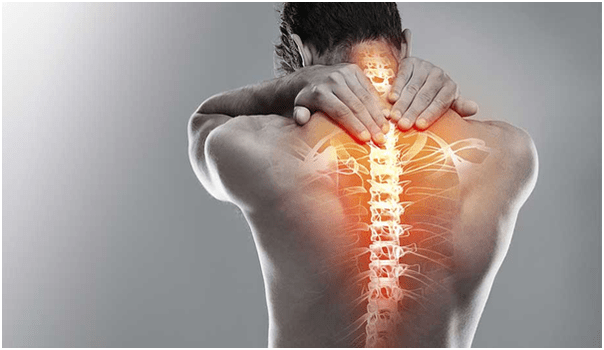
Pain in the cervical spine requires extreme attention. The reason lies in the unique anatomical features of the cervical vertebrae: the vertebral artery runs through it and supplies ⅓ of the brain with blood; the first and second cervical vertebrae form a mobile complex joint with the skull, which is responsible for turning and tilting the head; Any disease that occurs at this level can cause severe neurological damage, as damage or even slight compression of the spinal cord in the cervical spine immediately leads to an impairment of the motor and / or sensory function of the entire body.
Osteochondrosis of the cervical spine
Normally, intervertebral discs, joints, ligaments and tendons do not have their own blood vessels; their blood supply depends on how intensively the surrounding muscles and bones are supplied with blood. For example, if this process is disturbed in an office worker who leads a sedentary lifestyle, degenerative-dystrophic changes begin. The cartilage nourishment of the intervertebral discs and joints is impaired, the ligaments and tendons thicken, the spinal canal narrows due to sclerotic changes and the distance between the vertebrae decreases.
Among the non-experts, this disease is called spinal osteochondrosis. Although degenerative-dystrophic processes are characteristic of the entire spine, osteochondrosis is the most common cause of pain in the cervical spine. In addition, as in other parts of the spine, an intervertebral hernia can complicate this disease. However, due to the peculiarities of the anatomy of the cervical spine, even a small fracture can lead to serious complications.
trauma
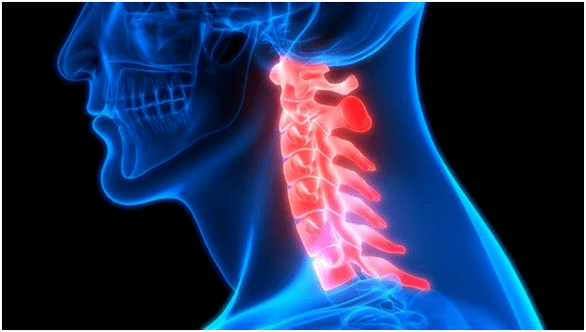
Although spinal cord injuries are more commonly diagnosed in the lumbar spine, nearly 50% of spinal cord injury cases occur with trauma to the cervical spine. This is due to the peculiarities of the anatomy of the neck: the lack of a developed muscle frame and massive vertebral bodies, high mobility even without direct physical influence contribute to the trauma (e. g. accident often occurs the so-called whiplash of the neck, caused by strong bending followed bystrong extension of the cervical spine). Pain is a constant companion of any spinal injury.
Myositis
Myositis, or inflammatory muscle disease, is a whole group of disorders that are characterized by muscle pain. The most common cause of banal muscle inflammation is a forced posture when working, hypothermia, drafts. Muscle pain can result from osteochondrosis of the cervical spine, herniated disc - the muscles take on most of the stress on the neck, which ultimately leads to overexertion, muscle spasms with impaired microcirculation and inflammation.
neuralgia
Neuralgia is a condition in which the nerve fibers themselves become a source of constant pain impulses. The pain is paroxysmal, can be aggravated and provoked by turning or tilting the head, cold weather. The cause of neuralgia is linked to diseases of the spine - osteochondrosis, intervertebral hernia, scoliosis, etc. The immediate cause of pain is irritation of the spinal cord roots when they become trapped in the intervertebral space, muscle spasms that disrupt the metabolism in the nerves running through the spasmodic muscles. In contrast to neuritis or inflammation of the nerve, with neuralgia pain occurs periodically, there are no pathological changes in the nerve fibers themselves.
Heart disease
Heart diseases such as angina pectoris, ischemic heart disease, arteriosclerosis of the coronary arteries are often accompanied by pain radiating to the left of the neck, lower jaw, shoulder and forearm. Pain can be accompanied by numbness, tingling on the skin, simulate pain in osteochondrosis of the cervical spine with a herniated disc. Often times, patients receive massage, physical therapy, visit other doctors, although an electrocardiogram is enough to diagnose the cause.
A distinctive feature of such pain is the ability of antianginal drugs that improve blood flow through the coronary arteries (Isoket, Nitroglycerin) to relieve pain within a few minutes.
Pain in the middle of the back
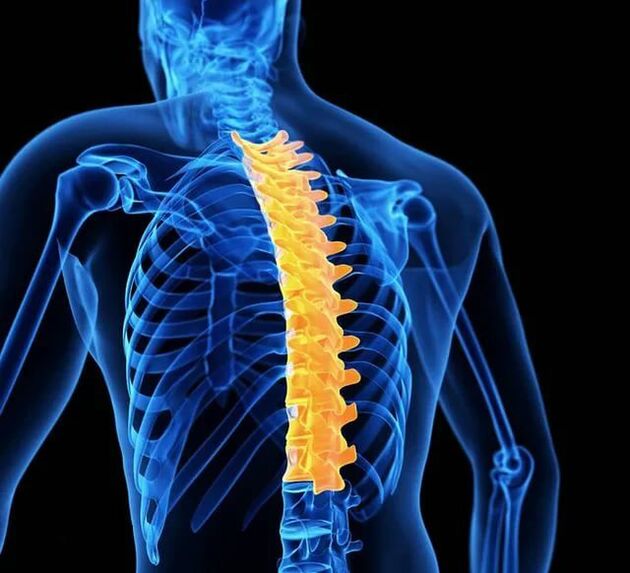
The thoracic spine consists of 12 thoracic vertebrae, each with a pair of ribs attached. Together they provide protection for the chest organs. The size of the thoracic vertebrae gradually increases, starting with 1 thoracic vertebra and continuing to the beginning of the lumbar spine - this is explained by a gradual increase in the load. The mobility of the middle back is significantly less than that of the neck, the ribs offer additional protection, which is why traumatic injuries to the spinal cord in the thoracic spine are less common.
Spine curvature or scoliosis
Scoliosis, or scoliotic disease, is a pathological curvature of the spine in multiple planes. The exact causes of scoliosis are not yet known; the disease begins in childhood. Inadequate physical activity, weakness of the back muscles, incorrect posture and organization of the workplace of school children are regarded as factors. Due to strong curvature, disturbed load distribution and biomechanics of the spine, overexertion of the muscles, which compensate for part of the load,developchronicBack pain.
Arthritis (spondyloarthritis)
The intervertebral joints, together with the intervertebral discs, unite the spine into a whole. Each vertebra has 4 articular surfaces that form joints with neighboring vertebrae. Like any other joint, the intervertebral joints can become inflamed. This pathological condition is called spondyloarthritis. There are two main causes of intervertebral joint inflammation. These are systemic rheumatic diseases (such as rheumatoid arthritis or ankylosing spondylitis) or reactive inflammation that occurs in response to increased stress in osteochondrosis, scoliosis, and other diseases of the spine. Inflamed joints lose their function: stiffness of movement, stiffness of the spine, persistent back pain.
Gastrointestinal disorders and back pain
Diseases of the abdominal organs are often the cause of reflected pain in the back and spine area. There is also a direct connection between diseases of the gastrointestinal tract and diseases of the musculoskeletal system. Diseases such as chronic colitis or gastroenteritis are the background to spondyloarthritis or osteochondrosis of the spine.
The most common back pain occurs in gastric and duodenal ulcers, hiatal hernia, acute or chronic pancreatitis. This phenomenon arises from the peculiarities of the sympathetic and parasympathetic systems, the nerve fibers of which are present in every organ of the abdominal cavity. Some of the pain impulses they perceive return to the roots of the spinal cord, simulating pain in the spine and back.
Kidney disease and back pain
The kidneys are a pair of organs located in the retroperitoneal space that, like the abdominal organs, are intimately connected to the roots of the spinal cord by nerves. In the case of inflammation, stones or other diseases of the urinary tract, some of the pain impulses reach the spinal cord and simulate a disease of the spine.Back pain symptomscan occur with acute pyelonephritis, renal colic, kidney abscesses. A characteristic symptom is tension in the muscles of the back in the projection of the kidneys, which occurs due to inflammation of the kidneys or an abscess of the tissues surrounding them.
Pain in the lumbosacral spine

The lumbosacral spine is the most stressed. Up to 60-70% of the adult population in developed countries complain of back pain. This is a popular location for intervertebral hernias. Most often, a patient is diagnosed with 2-3 hernias in the lumbosacral spine. Pain in the lower back and sacrum are also common with gynecological and urological pathologies.
Intervertebral hernia
A herniated disc is the result of long-term osteochondrosis of the spine. While relatively low loads are exerted on the intervertebral discs in the cervical area, each intervertebral disc is enormously stressed in the lumbosacral area. A healthy disc can counterbalance any weight due to the semi-liquid core that acts as a hydraulic shock absorber. However, due to osteochondrosis, the fibrous and strong cartilage (annulus fibrosus) that runs along the periphery of the intervertebral disc loses its elasticity and strength, and some of its parts can tear. With a strong increase in the load, for example when lifting weights, the pressure in the diseased intervertebral disc increases, whereby its contents can actually "shoot" through the damaged cartilage and fall into the lumen of the spinal canal - thus creating an intervertebral hernia.
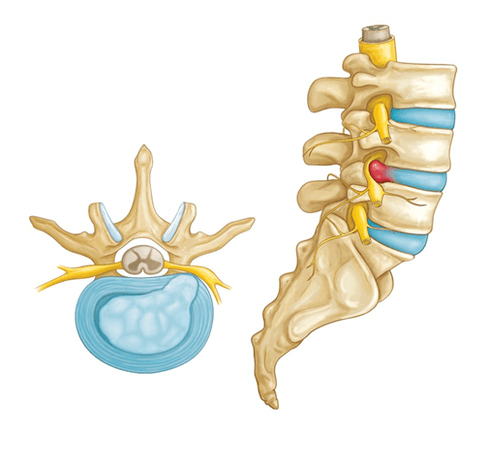
Nuclear fragments that have fallen out of the intervertebral disc squeeze the spinal cord and the roots of the spinal cord. As a result, there is a swelling of the nerve tissue and a circulatory disorder, which is accompanied by severe pain and protective muscle spasms. The pain can be excruciating, including the need to use narcotic analgesics. A characteristic feature is the radiation of pain in the lower extremities. The skin on the lower legs and thighs may be less sensitive to pain, tingling and numbness.
Disc protrusion
The main difference between a bulging disc and a hernia is the preservation of the integrity of the annulus fibrosus. The cause of pain is compression of the spinal cord and its roots by bulging along the periphery of the intervertebral disc. However, if the process continues, the protrusion can easily turn into a break. Symptoms and pain are similar to those of a herniated disc, as the severity of the pain syndrome depends not only on the size, but also on the location of the protrusion or hernia.
Spondylosis of the spine
Excessive loads and degenerative-dystrophic processes in the spine can lead to ossification of cartilage tissue, saturated with calcium salts, which turns into sharp coracoid bone outgrowths or growths that arise along the periphery of the vertebral bodies. As the process progresses, these outgrowths can merge with the same growths on the body of adjacent vertebrae. Over time, all vertebrae grow together, the spine loses flexibility and elasticity. The pain is caused by irritation of the spinal cord and its roots, reactive inflammation, and dystrophy of the soft tissues, ligaments, and muscles that surround the spine.
Radiculitis
Radiculitis is called severe pain caused by poor blood flow and ischemia of the roots of the spinal cord, strangled by a hernia or bulge with osteochondrosis of the spine. Various disorders of skin sensitivity in the area of the buttocks, perineum, thighs and lower legs are possible. Ejected sciatica leads to muscle wasting and weakness. A characteristic symptom is sharp pain along the sciatic nerve, aggravated by exercise, weight lifting, and in cold weather. This condition is called sciatica or sciatica.
Spinal infection
The vertebrae are made of spongy bone tissue that is rich in bone marrow. If an infection gets into the bloodstream of the vertebral body, an inflammatory process can occur - osteomyelitis. The gradual breakdown of bone tissue is accompanied by necrosis - this picture is also typical of spinal tuberculosis. Pain can occur both from irritation of the nerve endings and from pathological compression fractures of the spine, weakened by inflammation.
Gynecological and urological diseases
Pathologies such as cervical cancer, endometriosis or adnexitis (inflammation of the appendages of the uterus) in women, prostatitis or prostate cancer in men are often accompanied by severe pain in the lumbar spine. The nature of the pain is explained by irritation of the nerves in the area of inflammation or the growth of nerve trunks from a tumor.
Back muscles hurt along the spine
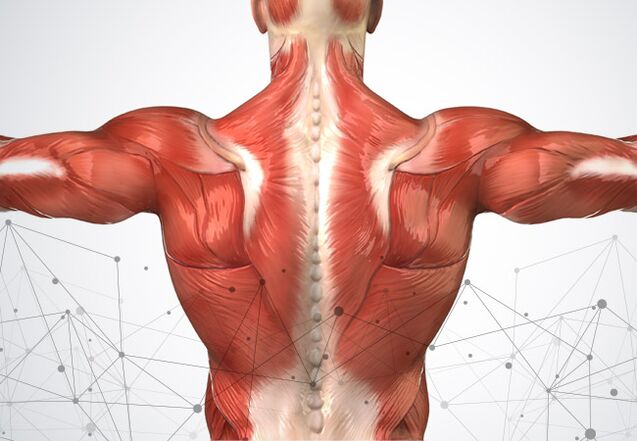
Well-developed back muscles are a sign of a healthy spine, as the muscle corset relieves some of the strain and additionally stabilizes the spine. In chronic diseases of the spine, the muscles are exposed to excessive loads, which weak and atrophied muscles cannot withstand. As a result, muscle spasms and due to metabolic disorders in muscles and pain occur. This condition is known as myofascial syndrome and is characteristic of osteochondrosis of the spine, hernias, and protrusions of the intervertebral discs.
Post-operative pain
Spinal surgery is usually associated with extensive trauma - to stabilize and restore the integrity of the vertebrae, doctors can resort to metal structures, screw screws into the vertebrae, and remove non-viable tissue. The pain in this case is due not only to the disease itself, but also to the operation. With proper rehabilitation and post-operative care, the pain will gradually go away. However, in the postoperative period, if you neglect the doctors' instructions and ignore the mandatory exercises, the pain can become chronic.
How are the causes of back pain diagnosed?
To diagnose back and spinal pain, it is necessary to seek medical help from a qualified neurologist in a timely manner. In the first phase, a neurological exam, a patient survey, an examination of the reflexes and symptoms are carried out. An experienced and competent doctor knows exactly what diseases back and spinal pain have for certain reasons and characteristic features.
Back pain for no apparent reason should be extra vigilant. This can be with reflected pain from other organs and systems, with tumors and diseases of the spinal cord.

To find out why your back and spine are sore, a neuropathologist may prescribe magnetic resonance imaging. It is the most effective and safest way to diagnose almost all possible causes of back pain. The procedure relies on the ability of magnetic fields and radio waves to provide clear and detailed images of the spine and spinal cord without the use of X-rays and other harmful factors.
How to Relieve Back Pain
To relieve back pain, but not treat it, let's take analgesics for several days, necessary waiting for the consultation of a specialist. The most common uses for this are non-steroidal anti-inflammatory drugs or NSAIDs. However, it is important to remember that this group of drugs can have dangerous side effects, the likelihood of which increases with prolonged use. It is therefore important not to postpone your visit to the doctor and the examination until later. treatmentDiseasesSpineand reasonsBack pain.
Treatment of spinal pain
As mentioned at the beginning, the effectiveness of back pain treatment depends on how precisely the diagnosis was made. Despite the obvious, many patients "cure" the pain for years, but not the disease itself, by postponing a visit to the doctor each time and turning to traditional healers, osteopaths, and chiropractors. Furthermore, such procedures are not only contraindicated in some diseases of the spinebut also dangerous.
There are effective and scientifically proven treatments for different onesspeciescausative diseasesBack pain. . . Many of these require the patient's perseverance and perseverance in battling the disease. It is important to remember that there are no pills or injections that can cure osteochondrosis - only you can, with hard training and physical exercises that a neurologist will show you.
Which doctor should I contact if I have pain in my spine?
Back pain is one of the most common neurological symptoms that occurs due to the involvement of the nerves and spinal cord in the pathological process. Therefore, the first specialist whose advice is needed in spinal pain will be a neurologist. Based on the results of the exam and magnetic resonance imaging, you may need to see another doctor. If back pain is caused by heart disease, the patient is referred to a cardiologist; if the problem is in the digestive tract, a gastroenterologist. But most often the pain syndrome is closely related to the pathology of the spine.

















































